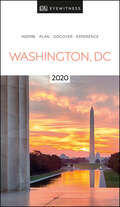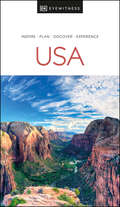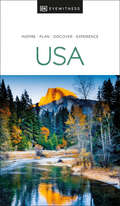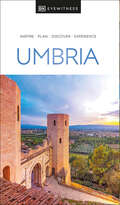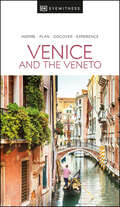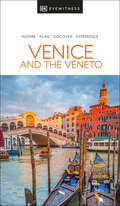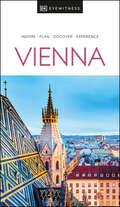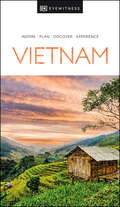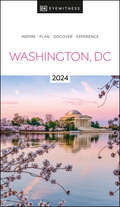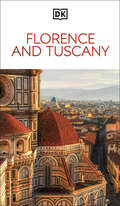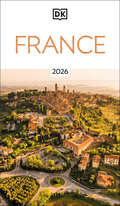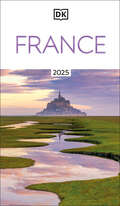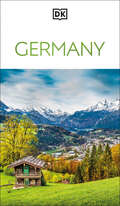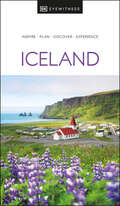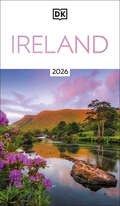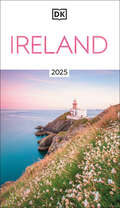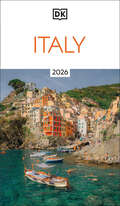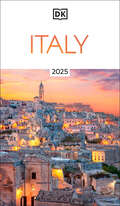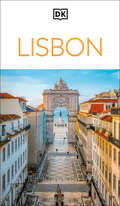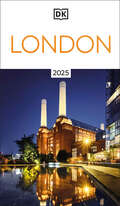- Table View
- List View
DK Eyewitness Travel Guide Washington, DC: 2020 (Travel Guide)
by DK EyewitnessPlanning a trip to Washington, DC? Look no further.Whether you want to stroll beneath the cherry blossoms, visit the iconic domed Capitol, or tour the magnificent White House, your DK Eyewitness travel guide makes sure you experience all that Washington, DC has to offer.Washington, DC delights at every turn. Wherever you go, there is a marvel of architecture to be discovered, a scenic view to be savored, or a world-famous museum to be enjoyed. And that's not to mention the lush green spaces and secret sanctuaries waiting to welcome weary travelers after a long day of sight-seeing.Our annually updated guide brings this beautiful city to life, transporting you there like no other travel guide does with expert-led insights and advice, detailed breakdowns of all the must-see sights, photographs on practically every page, and our trademark illustrations.You'll discover:- our pick of Washington, DC's must-sees, top experiences, and hidden gems- the best spots to eat, drink, shop, and stay- detailed maps and walks which make navigating the city easy- easy-to-follow itineraries- expert advice: get ready, get around, and stay safe- color-coded chapters to every part of Washington, DC from Capitol Hill to Penn Quarter, The Mall to GeorgetownHave less time? Try our pocket-friendly Top 10 Washington, DC for top 10 lists to all things Washington, DC.
DK Eyewitness USA (Travel Guide)
by DK EyewitnessWhether you want to hike in breathtaking Yosemite National Park, take a road trip from coast to coast or sample southern soul food in the Deep South, your DK Eyewitness travel guide makes sure you experience all that the USA has to offer.A nation of sublime extremes which spans broiling deserts and icy glaciers, soaring mountains and sultry swampland, cosmopolitan cities and eerie ghost towns. The USA is also a cultural superpower: world-class museums and galleries; the birthplace of jazz, blues and rock 'n' roll; the extravagance of Hollywood; and the draw of a rich multicultural heritage - the states have it all.Our recently updated guide brings the USA to life, transporting you there like no other travel guide does with expert-led insights and advice, detailed breakdowns of all the must-see sights, photographs on practically every page, and our hand-drawn illustrations which place you inside the country's iconic buildings and neighbourhoods. DK Eyewitness USA is your ticket to the trip of a lifetime. Inside DK Eyewitness USA you will find: - A fully-illustrated top experiences guide: our expert pick of the USA&’s must-sees and hidden gems- Accessible itineraries to make the most out of each and every day- Expert advice: honest recommendations for getting around safely, when to visit each sight, what to do before you visit, and how to save time and money- Color-coded chapters to every part of the USA, from from New York to Nevada, Maine to Montana- Practical tips: the best places to eat, drink, shop and stay- Detailed maps and walks to help you navigate the region country easily and confidently - Covers: New York City, The Mid Atlantic, New England, Washington, DC & the Capital Region, The Southeast, Florida, The Deep South, The Great Lakes, The Great Plains, Texas, The Southwest, The Rockies, The Pacific Northwest, California, Alaska & HawaiiWant to see more of the USA? Try our award-winning range of DK Eyewitness Travel Guides.About DK Eyewitness: At DK Eyewitness, we believe in the power of discovery. We make it easy for you to explore your dream destinations. DK Eyewitness travel guides have been helping travelers to make the most of their breaks since 1993. Filled with expert advice, striking photography and detailed illustrations, our highly visual DK Eyewitness guides will get you closer to your next adventure. We publish guides to more than 200 destinations, from pocket-sized city guides to comprehensive country guides. Named Top Guidebook Series at the 2020 Wanderlust Reader Travel Awards, we know that wherever you go next, your DK Eyewitness travel guides are the perfect companion.
DK Eyewitness USA (Travel Guide)
by DK EyewitnessGet closer to the USA with DK Eyewitness Seeing the sights of New York City. Taking a road trip along Route 66. Epic adventures in the Grand Canyon. The USA offers enough bucket list experiences to fill a lifetime. Whatever your dream trip involves, this DK Eyewitness travel guide is the perfect companion.Our updated guide brings the USA to life, transporting you there as no other travel guide does with expert-led insights, trusted travel advice, detailed breakdowns of all the must-see sights, photographs on practically every page, and our hand-drawn illustrations, which take you inside the country's buildings and neighborhoods.You'll discover:Our pick of the USA's must-sees and top experiencesBeautiful photography and detailed illustrations, taking you to the heart of the USAThe best spots to eat, drink, shop and stayDetailed maps and walks that make navigating the country easyEasy-to-follow itinerariesExpert advice: get ready, get around and stay safeColor-coded chapters to each part of the USAA lightweight format, so you can take it with you wherever you goSticking to one state? Look out for our DK Eyewitness guides to Alaska, California, Hawaii, Florida, and many more.DK is the world's leading illustrated reference publisher, producing beautifully designed books for adults and children in over 120 countries.
DK Eyewitness Umbria (Travel Guide)
by DK EyewitnessEnchanting hill towns. Wildlife-filled national parks. Ancient Roman ruins. There are countless reasons to visit Umbria. Whatever your dream trip involves, this DK Eyewitness travel guide is the perfect companion.With a brand-new design, beautiful new photography, and inspirational content, this fully updated guide brings Umbria to life, transporting you there like no other travel guide. You'll find trusted travel advice, expert-led insights, detailed breakdowns of all the must-see sights, photographs on practically every page, and our hand-drawn illustrations, which take you inside the region's buildings and neighborhoods.You'll discover: Our pick of Umbria's must-sees and top experiencesBeautiful photography and detailed illustrations, taking you to the heart of UmbriaThe best spots to eat, drink, shop and stayDetailed maps and walks that make navigating the region easyEasy-to-follow itinerariesExpert advice: get ready, get around and stay safeColor-coded chapters to each part of UmbriaA lightweight format, so you can take it with you wherever you go DK Eyewitness's highly visual guides show you what others only tell you, with easy-to-read maps, tips, and tours to inform and enrich your trip. Want to explore more of Italy? Try DK Eyewitness Italy.
DK Eyewitness Venice and the Veneto (Travel Guide)
by DK EyewitnessThe jewel of the Veneto, Venice is a dreamlike city filled with architectural wonders and incredible collections of art. But this region offers far more than this watery oasis. Lake Garda boasts beautiful scenery, Verona features the world's third-largest Roman Arena and the Dolomites are rich with alpine forests and verdant hills. Whether you want to wander around a magical maze of canals, sample delicious cuisine, ramble through majestic mountains or relive fascinating history, your DK Eyewitness travel guide makes sure you experience all that Venice and the Veneto have to offer. Our updated guide brings Venice and the Veneto to life, transporting you there like no other travel guide does with expert-led insights, trusted travel advice, detailed breakdowns of all the must-see sights, photographs on practically every page, and our hand-drawn illustrations which place you inside the region's iconic buildings and neighborhoods. We&’ve also worked hard to make sure our information is as up-to-date as possible following the COVID-19 outbreak. DK Eyewitness Venice and the Veneto is your ticket to the trip of a lifetime. Inside DK Eyewitness Venice and the Veneto you will find: - A fully-illustrated top experiences guide: our expert pick of Venice and Veneto&’s must-sees and hidden gems- Accessible itineraries to make the most out of each and every day- Expert advice: honest recommendations for getting around safely, when to visit each sight, what to do before you visit, and how to save time and money- Color-coded chapters to every part of Venice and the Veneto, from San Marco to the Lagoon Islands, Verona to the Dolomites- Practical tips: the best places to eat, drink, shop and stay- Detailed maps and walks to help you navigate the region easily and confidently - Covers: San Marco, San Polo and Santa Croce, Castello, Dorsoduro, Cannaregio, The Lagoon Islands, The Veneto Plain, Verona and Lake Garda, The Dolomites Touring the country? Don&’t forget to check out DK Eyewitness Italy. About DK Eyewitness: At DK Eyewitness, we believe in the power of discovery. We make it easy for you to explore your dream destinations. DK Eyewitness travel guides have been helping travelers to make the most of their breaks since 1993. Filled with expert advice, striking photography and detailed illustrations, our highly visual DK Eyewitness guides will get you closer to your next adventure. We publish guides to more than 200 destinations, from pocket-sized city guides to comprehensive country guides. Named Top Guidebook Series at the 2020 Wanderlust Reader Travel Awards, we know that wherever you go next, your DK Eyewitness travel guides are the perfect companion.
DK Eyewitness Venice and the Veneto (Travel Guide)
by DK EyewitnessWhether you want to wander around a magical maze of canals, sample delicious cuisine, ramble through majestic mountains, or relive fascinating history, your DK Eyewitness travel guide makes sure you experience all that Venice and the Veneto have to offer.The jewel of the Veneto, Venice is a dreamlike city filled with architectural wonders and incredible collections of art. But this region offers far more than this watery oasis. Lake Garda boasts beautiful scenery, Verona features the world's third-largest Roman Arena, and the Dolomites are rich with alpine forests and verdant hills.Our updated guide brings Venice and the Veneto to life, transporting you there like no other travel guide does with expert-led insights, trusted travel advice, detailed breakdowns of all the must-see sights, photographs on practically every page, and our hand-drawn illustrations that place you inside the region's iconic buildings and neighborhoods.You'll discover:-Our pick of Venice and the Veneto's must-sees, top experiences and hidden gems-The best spots to eat, drink, shop and stay-Detailed maps and walks that make navigating the region easy-Easy-to-follow itineraries-Expert advice: get ready, get around and stay safe-Color-coded chapters to every part of Venice and the Veneto, from San Marco to Castello, The Lagoon Islands to The Dolomites-A lightweight format, so you can take it with you wherever you goTouring the country? Don't forget to check out DK Eyewitness Italy.
DK Eyewitness Vienna (Travel Guide)
by DK EyewitnessA cornucopia of culture, Vienna puts art, music and theatre at centre stage. Whether you want to explore the stunning gardens of Schönbrunn Palace, gaze at Gustav Klimt's masterpieces at the Belvedere or cycle along the Danube embankment, your DK Eyewitness travel guide makes sure you experience all that Vienna has to offer.Steeped in imperial splendour, Vienna delights at every turn. From Roman ruins at the foot of the Hofburg to the tallest tower of Gothic Stephansdom, the city's landmarks are a testament to its rich history. And no list of Vienna's treasures would be complete without its engaging museums and world-famous classical music. Our newly updated guide brings Vienna to life, transporting you there like no other travel guide does with expert-led insights and advice, detailed breakdowns of all the must-see sights, photographs on practically every page, and our hand-drawn illustrations which place you inside the city's iconic buildings and neighborhoods. We&’ve also worked hard to make sure our information is as up-to-date as possible following the COVID-19 outbreak. DK Eyewitness Vienna is your ticket to the trip of a lifetime. Inside DK Eyewitness Vienna you will find: - A fully-illustrated top experiences guide: our expert pick of Vienna&’s must-sees and hidden gems- Accessible itineraries to make the most out of each and every day- Expert advice: honest recommendations for getting around safely, when to visit each sight, what to do before you visit, and how to save time and money- Color-coded chapters to every part of Vienna, from Stephansdom Quarter to Schottenring, Hofburg Quarter to Belvedere Quarter- Practical tips: the best places to eat, drink, shop and stay- Detailed maps and walks to help you navigate the state easily and confidently - Covers: Stephansdom Quarter, Hofburg Quarter, Schottenring and Alsergrund, Museum and Town Hall Quarter, Opera and Naschmarkt, Belvedere QuarterTouring the country? Try our DK Eyewitness Austria. Want the best of Vienna in your pocket? Try our DK Eyewitness Top 10 Vienna.About DK Eyewitness: At DK Eyewitness, we believe in the power of discovery. We make it easy for you to explore your dream destinations. DK Eyewitness travel guides have been helping travellers to make the most of their breaks since 1993. DK Eyewitness travel guides have been helping travelers to make the most of their breaks since 1993.Filled with expert advice, striking photography and detailed illustrations, our highly visual DK Eyewitness guides will get you closer to your next adventure. We publish guides to more than 200 destinations, from pocket-sized city guides to comprehensive country guides. Named Top Guidebook Series at the 2020 Wanderlust Reader Travel Awards, we know that wherever you go next, your DK Eyewitness travel guides are the perfect companion.
DK Eyewitness Vietnam (Travel Guide)
by DK EyewitnessVisit Southeast Asia&’s paradise!Taste traditional street food in Hanoi, cruise in Halong bay, explore nature and wildlife, take a boat trip through paddy fields and marvel at colonial architecture in Ho Chi Minh City. Your DK guide has it all: Welcome to Vietnam!Take the new lightweight Vietnam travel book wherever you go. Inside the pages of DK Eyewitness Vietnam, you&’ll find: • Our pick of Vietnam&’s must-sees, top experiences and hidden gems. • The best spots to eat, drink, shop and stay. • Detailed maps and walks to make navigating the country easy. • Easy-to-follow itineraries. • Expert advice: get ready, get around and stay safe. • Color-coded chapters to every part of Vietnam, from Ho Chi Minh City to Hanoi, the Mekong Delta to Northern Vietnam. Vietnam has a wealth of sights and experiences waiting to be discovered! From dramatic mountain landscapes in Sapa to long stretches of pristine, palm-fringed sands on the east coast. And with the country's rich history, delicious cuisine and friendly cities, there is plenty for you to enjoy. There are so many reasons to love Vietnam! Experience the best of this small Asian country in spectacular detail with photographs on practically every page, and hand-drawn illustrations that place you inside the country&’s iconic buildings and neighborhoods. This guidebook breaks up this bit of paradise into easily navigable adventures with expert local knowledge, trusted travel advice and comprehensive maps. From North to South Vietnam, excursions to Angkor, historical and religious sites like the temple of the Jade Emperor, and all the outdoor activities Vietnam has to offer!More trips to uncoverDK Eyewitness is the most up-to-date travel guide series following the COVID-19 outbreak. Each guide includes expert-led insights into the world&’s most famous countries and cities, things to do and places to stay. Want the best of Southeast Asia in your pocket? Try our Eyewitness Malaysia or Eyewitness Cambodia and Laos.
DK Eyewitness Washington DC (Travel Guide)
by DK EyewitnessWashington, DC delights at every turn. Wherever you go, there is a marvel of architecture to be discovered, a scenic view to be savored, or a world-famous museum to be enjoyed. And that's not to mention the lush green spaces and secret sanctuaries waiting to welcome weary travelers after a long day of sightseeing. Our updated guide brings Washington, DC to life, transporting you there like no other travel guide does with expert-led insights, trusted travel advice, detailed breakdowns of all the must-see sights, photographs on practically every page, and our hand-drawn illustrations which place you inside the city&’s iconic buildings and neighborhoods. Whether you want to stroll beneath the cherry blossoms, visit the iconic domed Capitol, or tour the magnificent White House, DK Eyewitness Washington DC is your ticket to the trip of a lifetime. Inside DK Eyewitness Washington, you will find: - A fully-illustrated top experiences guide: our expert pick of Washington DC&’s must-sees and hidden gems- Accessible itineraries to make the most out of each and every day- Expert advice: honest recommendations for getting around safely, when to visit each sight, what to do before you visit, and how to save time and money- Color-coded chapters to every part of Washington DC, from Capitol Hill to Penn Quarter, The Mall to Georgetown- Practical tips: the best places to eat, drink, shop and stay in Washington DC- Detailed maps to help you navigate the region easily and confidently - Explore the culture of Washington DC: delve into Washington DC&’s iconic history, art, and architecture- Covers: Capitol Hill, The Mall, Penn Quarter, White House and Foggy Bottom, Georgetown, South of the Mall, Northwest, Beyond the Center, and Days Out From Washington DC Planning on touring the USA? Don&’t forget to check out DK Eyewitness USA for a complete comprehensive guide to the States, making the most of your trip and achieving the adventure of a lifetime. About DK Eyewitness: At DK Eyewitness, we believe in the power of discovery. We make it easy for you to explore your dream destinations. Filled with expert advice, striking photography and detailed illustrations, our highly visual DK Eyewitness guides will get you closer to your next adventure. We publish guides to more than 200 destinations, from pocket-sized city guides to comprehensive country guides. Named Top Guidebook Series at the 2020 Wanderlust Reader Travel Awards, we know that wherever you go next, your DK Eyewitness travel guides are the perfect companion..
DK Florence and Tuscany (Travel Guide)
by DK TravelPlanning a trip to Italy? Add Florence and Tuscany to your travel bucket list!Whether you want to sample delicious Tuscan food and wine, gaze at the iconic Leaning Tower of Pisa or browse eclectic markets in Florence, your DK Eyewitness travel guide makes sure you experience all that Florence and Tuscany have to offer.Inside the pages of this Florence and Tuscany travel guide, you’ll discover: • Our pick of Florence and Tuscany’s must-sees, top experiences, hidden gems, and the best spots to eat, drink, shop, and stay • Detailed maps and walks make navigating the city easy • Easy-to-follow itineraries to help you plan your trip • Expert advice and travel tips to help you tick off unmissable sights, explore beyond the tourist hubs and soak up the atmosphere • Color-coded chapters to every part of Amsterdam, from the Central Canal Ring to the Museum Quarter and Plantage to Noord • Available in a handy format that is lightweight and portable Step into old Italian country-living and let the city go for a few days! Florence and Tuscany are brought to life by this updated city guide, transporting you to its mesmerizing architecture, quaint villages, and famous cultural attractions. Stunning photographs and hand-drawn illustrations will help you envisage your trip to this iconic region.See the birthplace of the Renaissance in Florence with its architectural masterpieces and dazzling collections of art. Exploring the Tuscan countryside is just as idyllic, with cypress-lined roads leading to picturesque towns and idyllic islands lying just off the coast.DK Eyewitness Florence and Tuscany have been updated regularly to make sure the information is as up-to-date as possible following the COVID-19 outbreak.For more than two decades, DK Eyewitness Guides have helped travelers experience the world through the history, art, architecture, and culture of their destinations. Expert travel writers and researchers provide independent advice, recommendations, and reviews. With guidebooks to hundreds of places around the globe available in print and digital formats, DK Eyewitness Guides show travelers how they can discover more.
DK France
by DK TravelWhether you want to visit fairytale châteaux, stroll amid rolling fields of blossoming lavender or learn what makes a noble vintage, your DK Eyewitness travel guide makes sure you experience all that France has to offer.Few countries capture the imagination quite like France. The world-famous cuisine is as rich and varied as the glorious landscapes, the wine as renowned and captivating as the art. From the alpine peaks to the Mediterranean beaches, each region has its own robust history and lively culture to inspire visitors.Our updated guide brings France to life, transporting you there like no other travel guide does with expert-led insights, trusted travel advice, detailed breakdowns of all the must-see sights, photographs on practically every page, and our hand-drawn illustrations which place you inside the country's iconic buildings and neighbourhoods. Our updated 2023 travel guide brings to life. DK Eyewitness France is your ticket to the trip of a lifetime. Inside DK Eyewitness France you will find: A fully-illustrated top experiences guide: our expert pick of France’s must-sees and hidden gems.Accessible itineraries to make the most out of each and every day.Expert advice: honest recommendations for getting around safely, when to visit each sight, what to do before you visit, and how to save time and money.Colour-coded chapters to every part of France, from Paris to the Pyrénées, Champagne to Corsica.Practical tips: the best places to eat, drink, shop and stayDetailed maps and walks to help you navigate the region country easily and confidently Covers: Île de France, Le Nord and Picardy, Champagne, Alsace and Lorraine, Normandy, Brittany, The Loire Valley, Franche-Comté, The Massif Central, The Rhône Valley and the French Alps, Poitou and Aquitaine, The Dordogne, The Pyrénées, Languedoc and Roussillon, Provence and the Côte d’Azur, CorsicaOnly visiting Paris? Try our DK Eyewitness Paris.About DK Eyewitness: At DK Eyewitness, we believe in the power of discovery. We make it easy for you to explore your dream destinations. DK Eyewitness travel guides have been helping travellers to make the most of their breaks since 1993. Filled with expert advice, striking photography and detailed illustrations, our highly visual DK Eyewitness guides will get you closer to your next adventure. We publish guides to more than 200 destinations, from pocket-sized city guides to comprehensive country guides. Named Top Guidebook Series at the 2020 Wanderlust Reader Travel Awards, we know that wherever you go next, your DK Eyewitness travel guides are the perfect companion.
DK France (Travel Guide)
by DK TravelWhether you want to visit fairytale châteaux, stroll amid rolling fields of blossoming lavender or learn what makes a noble vintage, your DK Eyewitness travel guide makes sure you experience all that France has to offer. Few countries capture the imagination quite like France. The world-famous cuisine is as rich and varied as the glorious landscapes, the wine as renowned and captivating as the art. From the alpine peaks to the Mediterranean beaches, each region has its own robust history and lively culture to inspire visitors.Our newly updated guide brings France to life, transporting you there like no other travel guide does with expert-led insights, trusted travel advice, detailed breakdowns of all the must-see sights, photographs on practically every page, and our hand-drawn illustrations which place you inside the country’s iconic buildings and neighborhoods. We’ve also worked hard to make sure our information is as up-to-date as possible following the COVID-19 outbreak. DK Eyewitness France is your ticket to the trip of a lifetime. Inside DK Eyewitness France you will find: A fully-illustrated top experiences guide: our expert pick France’s must-sees and hidden gems Accessible itineraries to make the most out of each and every day Expert advice: honest recommendations for getting around safely, when to visit each sight, what to do before you visit, and how to save time and money Color-coded chapters to every part of France, from Brittany to the French Alps, Provence to the Pyrénées Practical tips: the best places to eat, drink, shop and stay Detailed maps and walks to help you navigate the region country easily and confidently Covers: Île de la Cité, Marais and Beaubourg, Tuileries and Opéra, Champs-Elysées and Invalides, The Left Bank, Beyond the Centre, Île de France, Le Nord and Picardy, Champagne, Alsace and Lorraine, Normandy, Brittany, The Loire Valley, Franche-Comté, The Massif Central, The Rhône Valley and the French Alps, Poitou and Aquitaine, The Dordogne, The Pyrénées, Languedoc and Roussillon, Provence and the Côte d’Azur, CorsicaOnly visiting Paris? Don’t forget to check out DK Eyewitness Paris.About DK Eyewitness: At DK Eyewitness, we believe in the power of discovery. We make it easy for you to explore your dream destinations. DK Eyewitness travel guides have been helping travellers to make the most of their breaks since 1993. Filled with expert advice, striking photography and detailed illustrations, our highly visual DK Eyewitness guides will get you closer to your next adventure. We publish guides to more than 200 destinations, from pocket-sized city guides to
DK Germany (Travel Guide)
by DK TravelExplore Germany on your next travel adventure! Experience this European country’s best galleries, restaurants, attractions and historical sites. Walk the streets of Germany's medieval towns. Treat your senses to a sublime classical concert, local cuisine and art. Visit Bavaria’s castles. With endless inspiration, stunning photographs and expert advice, this guide will ensure your trip is effortless yet inspired. From North to South, East and West, this pocket travel book covers the best travel advice for your vacation to Germany. Inside, you’ll discover: • Our pick of Germany’s must-sees, top experiences and hidden gems. • The best spots to eat, drink, shop and stay. • Detailed maps and walks make navigating the region easy. • Easy-to-follow itineraries. • Expert advice: get ready, get around and stay safe. • Color-coded chapters to every part of Germany, from Berlin to Munich and Saxony to Hesse. • Our new lightweight format means you can take it with you wherever you go. Plan a trip to remember! Visit the historical Berlin Wall, hike the Bavarian Alps, stand at the Brandenburg Gate or Port of Hamburg, and taste Bavaria’s finest beer at Oktoberfest. Your DK Eyewitness guide will show you the best sites to see in Berlin, things to do in Munich, places to stay in Hamburg and so much more. Germany is synonymous with art and culture for those culturally inclined, bursting with world-class museums, trendy galleries and creative hubs. For nature-lovers, travel away from the towns and cities, and you’ll discover some of Europe's finest lakes, over 16 national parks, and a coastline boasting beautiful beaches and water sports.For more than two decades, DK Eyewitness guides have helped travelers experience the world through their destinations’ history, art, architecture and culture. Expert travel writers and researchers provide independent advice, recommendations and reviews. Discover guidebooks to hundreds of places around the globe!
DK Greek Islands (Travel Guide)
by DK TravelWhether you want to follow in the footsteps of legendary figures at the Minoan palace, swim in the turquoise waters of idyllic Zakynthos bay, or watch the sun set over Corfu from Kaiser's throne, your DK Eyewitness travel guide makes sure you experience all that the Greek Islands have to offer.The perfect escape, the Greek Islands offer spectacular beaches, crystal-clear seas, and picturesque villages. Though the islands vary greatly in character, they all share delicious cuisine, hospitable locals, and views capable of stealing your breath away.Our updated 2023 guide brings the Greek Islands to life, transporting you there like no other travel guide does with expert-led insights, trusted travel advice, detailed breakdowns of all the must-see sights, photographs on practically every page, and our hand-drawn illustrations which place you inside the region's iconic buildings and neighborhoods. DK Eyewitness Greek Islands is your ticket to the trip of a lifetime. Inside DK Eyewitness Greek Islands you will find: - A fully-illustrated top experiences guide: our expert pick of the Greek Islands’ must-sees and hidden gems.- Accessible itineraries to make the most out of each and every day.- Expert advice: honest recommendations for getting around safely, when to visit each sight, what to do before you visit, and how to save time and money.- Color-coded chapters to every part of the Greek Islands, from Athens to Crete, the Dodecanese to the Cyclades.- Practical tips: the best places to eat, drink, shop and stay.- Detailed maps and walks to help you navigate the region country easily and confidently .- Covers: The Ionian Islands, The Argo-Saronic Islands, The Sporádes and Évvia, The Northeast Aegean Islands, The Dodecanese, The Cyclades, Crete, AthensWant the best of the Greek Islands in your pocket? Try our DK Eyewitness Top 10 Greek Islands.Only visiting Crete? Try our DK Eyewitness Top 10 Crete.About DK Eyewitness: At DK Eyewitness, we believe in the power of discovery. We make it easy for you to explore your dream destinations. DK Eyewitness travel guides have been helping travelers to make the most of their breaks since 1993. Filled with expert advice, striking photography and detailed illustrations, our highly visual DK Eyewitness guides will get you closer to your next adventure. We publish guides to more than 200 destinations, from pocket-sized city guides to comprehensive country guides. Named Top Guidebook Series at the 2020 Wanderlust Reader Travel Awards, we know that wherever you go next, your DK Eyewitness travel guides are the perfect companion.
DK Hawaii (Travel Guide)
by DK TravelPacked with culture and activities for travelers to enjoy including beautiful beaches, volcanoes, and insider tips for everywhere from Honolulu to Waikiki. Try local delicacies with our guide to great restaurants and cafes featuring island cuisine, or check out the best restaurants, clubs, and bars. We have the best hotels for every budget, plus fun activities for solitary travel or for families and children to make the very best of any visit to Hawaii.Discover DK Eyewitness Travel Guide: Hawaii. • Hotel and restaurant listings and recommendations. • Detailed itineraries and "don't miss" destination highlights at a glance. • Illustrated cutaway 3-D drawings of important sights. • Floor plans and guided visitor information for major museums. • Guided walking tours, local drink and dining specialties to try, things to do, and places to eat, drink, and shop by area. • Area maps marked with sights. • Insights into history and culture to help you understand the stories behind the sights. With hundreds of full-color photographs, hand-drawn illustrations, and custom maps that illuminate every page, DK Eyewitness Travel Guide: Hawaii truly shows you Hawaii as no one else can.Series Overview: For more than two decades, DK Eyewitness Travel Guides have helped travelers experience the world through the history, art, architecture, and culture of their destinations. Expert travel writers and researchers provide independent editorial advice, recommendations, and reviews. With guidebooks to hundreds of places around the globe available in print and digital formats, DK Eyewitness Travel Guides show travelers how they can discover more.
DK Iceland (Travel Guide)
by DK TravelGet closer to Iceland with DK EyewitnessA soak in the surreal Blue Lagoon. Salmon and lobster feasts in Reykjavík. Witnessing the Northern Lights in midwinter. Iceland offers enough bucket-list experiences to fill a lifetime. Whatever your dream trip involves, this DK Eyewitness travel guide is the perfect companion.This new first edition brings Iceland to life, transporting you there as no other travel guide does with expert-led insights, trusted travel advice, detailed breakdowns of all the must-see sights, photographs on practically every page, and our hand-drawn illustrations, which take you inside the country's buildings and neighborhoods.You'll discover: Our pick of Iceland's must-sees and top experiencesThe best spots to eat, drink, shop and stayDetailed maps and walks that make navigating the country easyEasy-to-follow itinerariesExpert advice: get ready, get around and stay safeColor-coded chapters to each part of IcelandA lightweight format, so you can take it with you wherever you go Want the best of Iceland in your pocket? Try Top 10 Iceland.DK is the world's leading illustrated reference publisher, producing beautifully designed books for adults and children in over 120 countries.
DK Ireland
by DK TravelWhether you’re seeking the surreal beauty of the Giant’s Causeway, the historic halls of Trinity College, or the perfect pub to enjoy a pint of Guinness, your DK Eyewitness travel guide makes sure you experience all that Ireland has to offer.Small but spectacular, the Emerald Isle dazzles from coast to coast. Beloved by Hollywood filmmakers, Ireland’s dramatic beauty is instantly recognizable to visitors as the scene-stealing scenery of Star Wars and Game of Thrones. The urban landscape is just as enticing, with Belfast and Dublin offering their own unique identities, rich histories and great craic.Our annually updated guide brings Ireland to life, transporting you there like no other travel guide does with expert-led insights and advice, detailed breakdowns of all the must-see sights, photographs on practically every page, and our trademark illustrations. Our updated 2023 travel guide brings to life. DK Eyewitness Ireland is your ticket to the trip of a lifetime. Inside DK Eyewitness Ireland you will find: A fully-illustrated top experiences guide: our expert pick of Ireland’s must-sees and hidden gemsAccessible itineraries to make the most out of each and every dayExpert advice: honest recommendations for getting around safely, when to visit each sight, what to do before you visit, and how to save time and moneyColor-coded chapters to every part of Ireland, from Donegal to Dublin, Cork to Kilkenny.Practical tips: the best places to eat, drink, shop and stayDetailed maps and walks to help you navigate the region country easily and confidently Covers: Ireland at a Glance, Southeast Ireland, Cork and Kerry, The Lower Shannon, The West of Ireland, Northwest Ireland, The Midlands, Northern Ireland Planning a city break? Try our pocket-friendly DK Eyewitness Top 10 Dublin for top 10 lists to all things Dublin.About DK Eyewitness: At DK Eyewitness, we believe in the power of discovery. We make it easy for you to explore your dream destinations. DK Eyewitness travel guides have been helping travellers to make the most of their breaks since 1993. Filled with expert advice, striking photography and detailed illustrations, our highly visual DK Eyewitness guides will get you closer to your next adventure. We publish guides to more than 200 destinations, from pocket-sized city guides to comprehensive country guides. Named Top Guidebook Series at the 2020 Wanderlust Reader Travel Awards, we know that wherever you go next, your DK Eyewitness travel guides are the perfect companion.
DK Ireland: The Definitive Visual Guide, New Edition (Travel Guide)
by DK TravelSmall but spectacular, the Emerald Isle dazzles from coast to coast. Whether you’re seeking the surreal beauty of the Giant’s Causeway, the historic halls of Trinity College, or the perfect pub to enjoy a pint of Guinness, your DK Eyewitness travel guide makes sure you experience all that Ireland has to offer.Beloved by Hollywood filmmakers, Ireland’s dramatic beauty will no doubt be recognizable to visitors as the backdrop of Star Wars and Game of Thrones. The cities, meanwhile, beckon with the promise of cosy pubs and charming locals. And with Belfast and Dublin offering their own unique identities and rich histories, Ireland’s two capitals are sure not to disappoint.Our annually updated guide brings Ireland to life, transporting you there like no other travel guide does with expert-led insights and advice, detailed breakdowns of all the must-see sights, photographs on practically every page, and our trademark illustrations.You'll discover: - our pick of Ireland’s must-sees, top experiences, and hidden gems - the best spots to eat, drink, shop, and stay - detailed maps and walks which make navigating the country easy - easy-to-follow itineraries - expert advice: get ready, get around, and stay safe - color-coded chapters to every part of Ireland, from Donegal to Dublin, Cork to Kilkenny - our new lightweight format, so you can take your guide with you wherever you goPlanning a city break? Try our pocket-friendly Top 10 Dublin for top 10 lists to all things Dublin.
DK Italy
by DK TravelWhether you want to explore the evocative ruins of an ancient empire, traverse Tuscany’s vineyard-cloaked hills, or simply sip espresso and watch the world go by, your DK Eyewitness travel guide makes sure you experience all that Italy has to offer.From erupting volcanoes to magnificent coastal scenery, this breathtaking country is rich in natural beauty. And with more UNESCO World Heritage Sites than anywhere else on Earth, there is no better place to experience the glories of European art and architecture. Of course, Italy is not only a sumptuous feast for the eyes; famous for some of the world’s finest food and wine, the country’s vibrant gastronomic traditions differ from one town to the next.Our newly updated guide brings Italy to life, transporting you there like no other travel guide does with expert-led insights, trusted travel advice, detailed breakdowns of all the must-see sights, photographs on practically every page, and our hand-drawn illustrations which place you inside the country’s iconic buildings and neighborhoods. DK Eyewitness Italy is your ticket to the trip of a lifetime. Inside DK Eyewitness Italy you will find: - A fully-illustrated top experiences guide: our expert pick of Italy’s must-sees and hidden gems- Accessible itineraries to make the most out of each and every day- Expert advice: honest recommendations for getting around safely, when to visit each sight, what to do before you visit, and how to save time and money- Color-coded chapters to every part of Italy, from Venice to Rome, Sicily to Sardinia- Practical tips: the best places to eat, drink, shop and stay- Detailed maps and walks to help you navigate the region country easily and confidently - Covers: Northern Italy, Venice, The Veneto and Friuli, Trentino-Alto Adige, Milan, Lombardy and the Lakes, Valle d'Aosta and Piedmont, Liguria, Central Italy, Rome, Lazio, Florence, Tuscany, Umbria, Le Marche, Emilia-Romagna, Southern Italy, Naples, Campania, Abruzzo, Molise and Puglia, Basilicata and Calabria, Sicily, SardiniaOnly visiting Rome? Don’t forget to check out DK Eyewitness Rome. About DK Eyewitness: At DK Eyewitness, we believe in the power of discovery. We make it easy for you to explore your dream destinations. DK Eyewitness travel guides have been helping travelers to make the most of their breaks since 1993. Filled with expert advice, striking photography and detailed illustrations, our highly visual DK Eyewitness guides will get you closer to your next adventure. We publish guides to more than 200 destinations, from pocket-sized city guides to comprehensive country guides. Named Top Guidebook Series at the 2020 Wanderlust Reader Travel Awards, we know that wherever you go next, your DK Eyewitness travel guides are the perfect companion.
DK Italy (Travel Guide)
by DK TravelLive la dolce vita and explore Italy’s hidden gems, must-sees, and top experiences.Whether you want to explore the evocative ruins of an ancient empire, go wine tasting in Tuscany, or sip espresso and watch the world go by on one of the magnificent piazzas, your DK Eyewitness travel guide makes sure you experience all that Italy has to offer.Inside the pages of this Italy travel guide, you’ll discover: - Our pick of Italy’s best spots to eat, drink, shop, and stay - Detailed maps and walks make navigating the city easy - Easy-to-follow itineraries to help you plan your trip - Expert advice and travel tips to help you get ready, get around, and stay safe - Color-coded chapters to every part of Italy, from Venice to Rome, and Sicily to Sardinia - Available in a handy format that is lightweight and portableEmbark on a Latin adventureTick Italy off your bucket list and see the best that this culture-rich nation has to offer - from its rich natural beauty to sumptuous food and wine. This updated travel guide combines expert-led insights and detailed breakdowns of all the must-see sights with stunning imagery to bring Italy to life. With more UNESCO World Heritage Sites than anywhere else on Earth, there is no better place to experience the glories of European art and architecture. Witness the refined Renaissance churches of Florence, bask on the unspoiled beaches of Puglia, or ski the spectacular slopes of the Dolomites. There is something for everyone!DK Eyewitness Italy has been updated regularly to make sure the information is as up-to-date as possible following the COVID-19 outbreak.More adventures to uncoverFor more than two decades, DK Eyewitness guides have helped travelers experience the world through the history, art, architecture, and culture of their destinations. Expert travel writers and researchers provide independent advice, recommendations, and reviews. Discover guidebooks to hundreds of places around the globe!
DK Japan
by DK TravelWhether you want to see cherry blossoms in Kyoto, speed through the countryside aboard a shinkansen, or shop til you drop in futuristic Shibuya, your DK Eyewitness travel guide makes sure you experience all Japan has to offer. Japan is a land of contrast – think tranquil zen gardens and peaceful pagodas, neon-lit cities and robot restaurants. Cities might be the first things that spring to mind when you think of Japan, but the countryside is just as epic. There’s the iconic Mount Fuji, bubbling hot springs, unspoiled beaches and adrenaline-packed ski resorts. And if that wasn’t enough to entice you to visit, there’s the food – unctuous noodles, delicate sushi and warming hotpots.Our updated guide brings Japan to life, transporting you there like no other travel guide does with expert-led insights, trusted travel advice, detailed breakdowns of all the must-see sights, photographs on practically every page, and our hand-drawn illustrations which place you inside the country's iconic buildings and neighborhoods. DK Eyewitness Japan is your ticket to the trip of a lifetime. Inside DK Eyewitness Japan you will find: - A fully-illustrated top experiences guide: our expert pick of Japan’s must-sees and hidden gems- Accessible itineraries to make the most out of each and every day- Expert advice: honest recommendations for getting around safely, when to visit each sight, what to do before you visit, and how to save time and money- Color-coded chapters to every part of from Tokyo to Kyoto City, Hokkaido to Okinawa- Practical tips: the best places to eat, drink, shop and stay- Detailed maps and walks to help you navigate the region country easily and confidently - Covers: Central Tokyo, Northern Tokyo, Western Tokyo, Farther Afield, Central Honshu Kyoto City, Western Honshu, Shikoku, Kyushu, Okinawa, Northern Honshu, HokkaidoOnly visiting Tokyo? Try our DK Eyewitness Tokyo.About DK Eyewitness: At DK Eyewitness, we believe in the power of discovery. We make it easy for you to explore your dream destinations. DK Eyewitness travel guides have been helping travelers to make the most of their breaks since 1993. Filled with expert advice, striking photography and detailed illustrations, our highly visual DK Eyewitness guides will get you closer to your next adventure. We publish guides to more than 200 destinations, from pocket-sized city guides to comprehensive country guides. Named Top Guidebook Series at the 2020 Wanderlust Reader Travel Awards, we know that wherever you go next, your DK Eyewitness travel guides are the perfect companion.
DK Japan (Travel Guide)
by DK TravelWhether you want to see cherry blossoms in Kyoto, speed through the countryside aboard a shinkansen, or shop til you drop in futuristic Shibuya, your DK Eyewitness travel guide makes sure you experience all Japan has to offer. Japan is a land of contrast – think tranquil zen gardens and peaceful pagodas, neon-lit cities and robot restaurants. Cities might be the first things that spring to mind when you think of Japan, but the countryside is just as epic. There’s the iconic Mount Fuji, bubbling hot springs, unspoiled beaches and adrenaline-packed ski resorts. And if that wasn’t enough to entice you to visit, there’s the food – unctuous noodles, delicate sushi and warming hotpots.Our updated guide brings Japan to life, transporting you there like no other travel guide does with expert-led insights, trusted travel advice, detailed breakdowns of all the must-see sights, photographs on practically every page, and our hand-drawn illustrations which place you inside the country's iconic buildings and neighborhoods. DK Eyewitness Japan is your ticket to the trip of a lifetime. Inside DK Eyewitness Japan you will find: - A fully-illustrated top experiences guide: our expert pick of Japan’s must-sees and hidden gems- Accessible itineraries to make the most out of each and every day- Expert advice: honest recommendations for getting around safely, when to visit each sight, what to do before you visit, and how to save time and money- Color-coded chapters to every part of from Tokyo to Kyoto City, Hokkaido to Okinawa- Practical tips: the best places to eat, drink, shop and stay- Detailed maps and walks to help you navigate the region country easily and confidently- Covers: Central Tokyo, Northern Tokyo, Western Tokyo, Farther Afield, Central HonshuKyoto City, Western Honshu, Shikoku, Kyushu, Okinawa, Northern Honshu, HokkaidoOnly visiting Tokyo? Try our DK Eyewitness Tokyo.About DK Eyewitness:At DK Eyewitness, we believe in the power of discovery. We make it easy for you to explore your dream destinations. DK Eyewitness travel guides have been helping travelers to make the most of their breaks since 1993. Filled with expert advice, striking photography and detailed illustrations, our highly visual DK Eyewitness guides will get you closer to your next adventure. We publish guides to more than 200 destinations, from pocket-sized city guides to comprehensive country guides. Named Top Guidebook Series at the 2020 Wanderlust Reader Travel Awards, we know that wherever you go next, your DK Eyewitness travel guides are the perfect companion.
DK Lisbon (Travel Guide)
by DK TravelPlan the perfect once-in-a-lifetime trip to Lisbon with this portable travel guide.Whether you want to stroll through the jumbled streets of Alfama, take in the fantastic views from Castelo de São Jorge, or sample the city’s iconic custard tarts, Pasteis de Nata, at Belém, your DK Eyewitness travel guide makes sure you experience all that Lisbon has to offer.Inside the pages of this Lisbon travel guide, you’ll discover: • Our pick of Lisbon’s must-sees, top experiences, hidden gems, and the best spots to eat, drink, shop, and stay • Detailed maps and walks make navigating the city easy • Easy-to-follow itineraries to help you plan your trip • Expert advice and travel tips to help you get ready, get around, and stay safe • Color-coded chapters to every part of Lisbon, from Alfama and Baixa to Bairro Alto and Belém • Available in a handy format that is lightweight and portable Your next favourite holiday destination is LisbonHip, innovative, and affordable, Lisbon is definitely a bucket list destination! DK Eyewitness: Lisbon is the ideal pocket companion for your trip to the gorgeous Portuguese capital. Full color and packed with expert insights, travel advice, and detailed breakdowns of all the must-see sights and experiences, this guide will transport you there like no other.One of the most charismatic and vibrant cities in Europe, Lisbon has an incredible mix of historic museums, colorful buildings, eclectic music and nightlife, squares, and cafés to watch the world go by. Hop on one of the city’s yellow trams, see a traditional Fado show or take a day trip to the fairy tale village of Sintra. Lisbon is ready to take your breath away!DK Eyewitness Lisbon has been updated regularly to make sure the information is as up-to-date as possible following the COVID-19 outbreak.More locations to EyewitnessFor more than two decades, DK Eyewitness guides have helped travelers experience the world through the history, art, architecture, and culture of their destinations. Expert travel writers and researchers provide independent advice, recommendations, and reviews. Discover guidebooks to hundreds of places around the globe!
DK London
by DK TravelWinner, Gold Award, Top Guidebook at the 2020 Wanderlust Magazine Reader Travel Awards.Planning a trip to London? Look no further. Whether you want to tread the footsteps of kings and queens in the royal palaces, catch a show in the vibrant West End theater district, or sample the tantalizing array of street food from around the world, your DK Eyewitness travel guide makes sure you experience all that London has to offer. Every corner of London is brimming with personality. Dripping in pomp and tradition, Whitehall and Westminster are best known for their iconic sights and regal architecture. The rolling fields and peaceful woodlands of Hampstead Heath feel a world apart from the financial district of the City, where corporate suits can be seen flocking into futuristic skyscrapers. And when the sun sets, Soho bursts into life - the perfect spot for an evening out. Our annually updated guide brings this cosmopolitan capital to life, transporting you there like no other travel guide does with expert-led insights and advice, detailed breakdowns of all the must-see sights, photographs on practically every page, and our trademark illustrations. You'll discover: - our pick of London's must-sees, top experiences, and hidden gems - the best spots to eat, drink, shop, and stay - detailed maps and walks which make navigating the city easy - easy-to-follow itineraries - expert advice: get ready, get around, and stay safe - color-coded chapters to every part of London, from Mayfair to Shoreditch, King's Cross to the South Bank - our new lightweight format, so you can take your guide with you wherever you go Have less time? Try our pocket-friendly Top 10 London for top 10 lists to all things London.
DK London (Travel Guide)
by DK TravelWinner, Gold Award, Top Guidebook at the 2020 Wanderlust Magazine Reader Travel Awards.Planning a trip to London? Look no further.Whether you want to tread the footsteps of kings and queens in the royal palaces, catch a show in the vibrant West End theater district, or sample the tantalizing array of street food from around the world, your DK Eyewitness travel guide makes sure you experience all that London has to offer.Every corner of London is brimming with personality. Dripping in pomp and tradition, Whitehall and Westminster are best known for their iconic sights and regal architecture. The rolling fields and peaceful woodlands of Hampstead Heath feel a world apart from the financial district of the City, where corporate suits can be seen flocking into futuristic skyscrapers. And when the sun sets, Soho bursts into life - the perfect spot for an evening out.Our annually updated guide brings this cosmopolitan capital to life, transporting you there like no other travel guide does with expert-led insights and advice, detailed breakdowns of all the must-see sights, photographs on practically every page, and our trademark illustrations.You'll discover:- our pick of London's must-sees, top experiences, and hidden gems- the best spots to eat, drink, shop, and stay- detailed maps and walks which make navigating the city easy- easy-to-follow itineraries- expert advice: get ready, get around, and stay safe- color-coded chapters to every part of London, from Mayfair to Shoreditch, King's Cross to the South Bank- our new lightweight format, so you can take your guide with you wherever you goHave less time? Try our pocket-friendly Top 10 London for top 10 lists to all things London.
